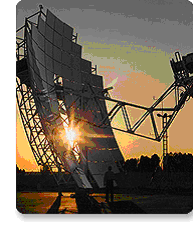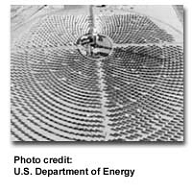Whereas solar photovoltaic panels are installed directly on buildings and convert sunlight into electricity, solar thermal power is both more complicated and simpler: it uses mirrors to concentrate sunlight and heat liquids, which are then used to drive turbines to make electricity. Solar thermal has as much potential as solar photovoltaics and maybe more because it can be deployed on a large scale - big enough to light up shopping malls or towns, not just a home or a building.
Like solar photovoltaics, solar thermal has been around for a long time. The problem is, until now, it's been too expensive and the electricity generation too intermittent (think lack of sunlight) to compete with coal or nuclear power plants.
Solar thermal's day, however, may finally have arrived, thanks to improved technology, federal tax credits and state requirements that utilities buy power from renewable sources. Federal climate change legislation - which, if enacted, would drive up the cost of electricity from fossil fuels - has also tilted the playing field in favor of low-carbon power sources like solar thermal and wind power.
As much as PV, this is an area that has huge amounts of venture capital pouring into it, and adherents claim that there are enough jiga-watts available to power the entire USA. This will be an interesting story to watch.
There are three main types of concentrating solar power systems: parabolic-trough , dish/engine , and power tower .
Parabolic-trough systems concentrate the sun's energy through long rectangular, curved (U-shaped) mirrors. The mirrors are tilted toward the sun, focusing sunlight on a pipe that runs down the center of the trough at a central point above the curve of the mirror. The mirror focumses the sunlight on the pipe causing it to get got enough that it can boil water into steam. Alternately oil can be pumped through the pipe which in turn is used to boil water in a conventional steam generator to turn a turbine to produce electricity.

A 25-kilowatt Dish Stirling System catches its last rays of light at the end of the day. Credit: Stirling Energy Systems
A power tower system uses a large field of mirrors to concentrate sunlight onto the top of a tower, where a receiver sits. This heats molten salt flowing through the receiver. Then, the salt's heat is used to generate electricity through a conventional steam generator. Molten salt retains heat efficiently, so it can be stored for days cloudy days or even several hours after sunset.
The picture at right shows the Solar Two Project, in which sunlight is reflected off 1,800 mirrors circling the tall tower. The mirrors are called heliostats and move and turn to face the sun all day long.
 The light is reflected back to the top of the tower in the center of the circle where a fluid is turned very hot by the sun's rays. That fluid can be used to boil water to make steam to turn a turbine and a generator.
The light is reflected back to the top of the tower in the center of the circle where a fluid is turned very hot by the sun's rays. That fluid can be used to boil water to make steam to turn a turbine and a generator.
A dish/engine system uses a mirrored dish (similar to a very large satellite dish). The dish-shaped surface collects and concentrates the sun's heat onto a receiver, which absorbs the heat and transfers it to fluid within the engine. The heat causes the fluid to expand against a piston or turbine to produce mechanical power. The mechanical power is then used to run a generator or alternator to produce electricity.
Solar Energy Engineering |
Why Solar Energy? |
Photovoltaics |
Passive Solar Systems & Solar Hot Water